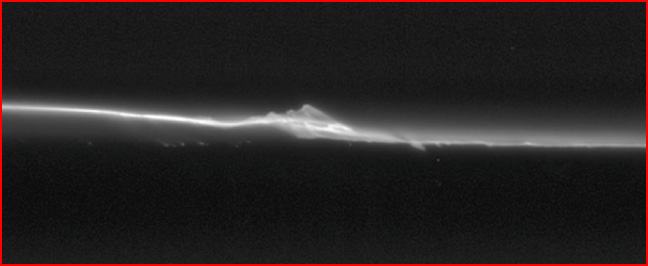
home •
about •
essential guide •
picture of the day •
thunderblogs •
news •
multimedia •
predictions •
products •
get involved •
contact
picture of the day archive subject index
Edge-on image of Saturn's F-ring. Credit: NASA/JPL Cassini-Huygens mission.
May 09, 2008
Kinks in Saturn's Rings
Braids and twists in the rings of Saturn suggest activity in addition to gravitational attraction. Could electricity be one of the formative agents?Saturn's F-ring was discovered by Pioneer 11 during its 1979 flyby of the giant planet. When the Voyager 1 space probe passed by Saturn in November of 1980, it returned stunning pictures of Saturn's rings that were completely unanticipated. Two of the most intriguing discoveries were the "spokes" seen drifting above the ring plane and the twisted and interlaced structure of the F-ring.
Voyager 2's higher resolution camera found five separate strands in a region with no braiding and one small section where the F-ring was twisted. Additional polarized light images of the brightest F-ring filaments proved them to be subdivided into at least ten smaller strands. The twists in the ring are theorized to be gravitational perturbations caused by one of two "shepherd moons," Prometheus.
The Cassini-Huygens mission placed an observation platform in orbit around Saturn, designed to last until mid-2008. Several images of the F-ring seem to indicate a helical structure that twists around a central cylinder, rather than a braid. There are what look like three toroidal shapes visible in the image at the top of the page, with the tips of many others visible along the strand. In the center of the three helical filaments is a bright, rotating tube that shows where the forces have become concentrated.
In previous Thunderbolts Picture of the Day articles about the plasmasphere around Saturn, it was noted that planets and moons do not exist in an electrically neutral environment. Saturn, in particular, has a family of moons that exhibit electric discharge machining on a vast scale, as well as features within its atmosphere that could be characterized as lightning discharges. Its aurora are an intense radio-emitter and the planet is surrounded by a torus of plasma that emits x-rays and extreme ultra-violet light. Saturn seems to display many aspects that are predicted by the Electric Universe theory, including the shape of its rings.
Bodies immersed in plasma aren't isolated, they are connected by circuits. Most of the time they are not in equilibrium because they are in unstable conditions. The majority of them are moving across the plasma filaments that exist in the solar system and in the plasmaspheres around planets. Currents in plasma contract into filaments and the force between filaments is linear, so the electromagnetic fields created by the filaments are the most powerful long-range attractor in the universe.
In 1913, Kristian Birkeland conducted his now-famous experiment where a small, magnetized iron globe was placed in a vacuum and used as the cathode in electric discharges. As he wrote about Saturn's rings: "It seems almost incredible that such a ring of cosmic dust should be able to exist for ever, so to speak, without other governing forces than gravitation..."
Plasma physics experimenter, author and theorist Wal Thornhill wrote in agreement with Birkeland's work:
"As shown in [Birkeland's] laboratory experiments, the inflowing [conventionally] electric current forms a plasma donut where the electrical energy is stored. It is that energy that drives the winds and lightning on Saturn...In fact, Saturn has two plasmoids. One is outside the rings, the other inside the rings. Discharges to Saturn must cross the rings."
Rather than relying on the gravity-only model of the solar system and its insistence that Saturn's rings can only be created, held and shaped by the activity of "shepherd moons" and angular momentum, we should look to a force that is orders of magnitude more powerful: electricity.
By Stephen Smith
___________________________________________________________________________Please visit our Forum
The Electric Sky and The Electric Universe available now!

|
|

|
EXECUTIVE EDITORS:
David Talbott, Wallace Thornhill
MANAGING EDITORS:
Steve Smith, Mel Acheson
CONTRIBUTING EDITORS: Michael Armstrong, Dwardu Cardona,
Ev Cochrane,
C.J. Ransom, Don Scott, Rens van der Sluijs, Ian Tresman
WEBMASTER: Brian Talbott
Copyright 2008: thunderbolts.info
![]()
home •
thunderblogs •
forum •
picture of the day •
resources •
team •
updates •
contact us

